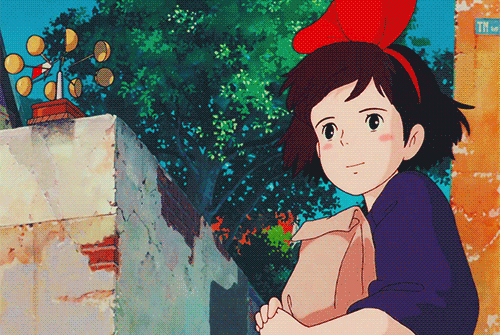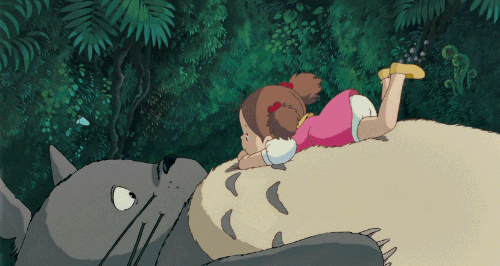Why Ghibli films are beloved
By: Goh Qian Yi
October 17, 2021

Kiki's Delivery Service (1989), Studio Ghibli
When one thinks about Studio Ghibli, do they think about the tear-stained rice balls, the red rust tinged box of fruit drops, the steam train that keeps on going forever across the endless sea, or the simplicity of the slopes of green grass swaying to the song of the wind?
For those who have been living under a rock and never happened to come across this phenomenal household name, Studio Ghibli is a Japanese animation film studio that has relished in holding the beating heart of the Japanese animation industry. They are best known worldwide for it’s critically acclaimed and beloved animated feature films, some of which include: Spirited Away, Howl’s Moving Castle, My Neighbor Totoro, and Princess Mononoke. Their movies resonate with people from all walks of life purely because of their wonderfully executed exploration of universal humanistic themes while painting them into unique worlds brimming with whimsy and atmosphere.
Anyone could watch a Studio Ghibli film and fall hopelessly in love with it. To explain how masterful the studio is with their crafts, even the films that are considered the ‘worst’ are still above the average standards of a Western movie. To say the expectations for a Ghibli film are high would be a bit of an understatement. But what exactly makes a Ghibli film a Ghibli film? At first glance Princess Mononoke, a fantasy filled adventure film where nature and industrialization come into harsh conflict, could not possibly have any similarities whatsoever with a slice of life film like Whisper of The Heart, which challenges the main protagonist with the question of her path in life.
But believe me when I say that after you peel back all of these layers, you'll realise what makes a film exude the Ghibli effect and how even after 37 years they have managed to maintain their prodigious reputation and remain in the hearts of those who watched it.

My Neighbor Totoro (1988), Studio Ghibli
First and foremost, in order to tell a compelling and impactful story, world-building plays a large role in constructing an immersive world. Sometimes especially in their more fantastical genre films there is more attention to detail in the world system, but like everything else it all comes to the same destination: that it must suspend our disbelief, hook us in, and make us believe in the possibilities of the impossible. This quality is referred to as immersive realism, a quality that can be found in all of Ghibli films. Through their breathtaking animation and attention to miniscule details of ordinary actions, they have managed to consistently merge an abstract balance between reverie and reality. Bringing a world to life is often a daunting mission that’s on the storytellers and animators’ backs, but this is where Studio Ghibli truly excels. There is strict attention to every visual scene in a film that further fortifies the story being portrayed. So no matter how unbelievable and dreamy the story is, there’s always a grounding sense of reality and tangibility within each movement and scene. Hayao Miyazaki, the man behind Studio Ghibli, has once even stated before: “Anime may depict fictional worlds, but I nonetheless believe that at its core it must have a certain realism.... The animators must fabricate a lie that seems so real, viewers will think the world depicted might possibly exist.”
The visual animation of all their films are an essential part of illustrating the entire story, and when it comes to this there isn’t one scene that makes it feel unnatural. Think about how the animated movements interact with the world around them; like how in Spirited Away, Chihiro scuffs her shoes against the floor to make sure they fit her feet, when the animators could have simply animated Chihiro slipping on her shoes and walking away.
Animate. The word quite literally means bring to life. Many people and even Miyazaki argue that animators are themselves actors, as they bring visuals to the scene and must emphasize their characters in order to sell a beautiful lie. By emphasizing each character’s motivations and personality, they are able to animate these tiny nuances in their character movements. “The scene where Chihiro puts her feet into her shoe, and it would just be a very simple scene, you might just animate it and she puts her shoes on and moves, runs off,” Glen Keane, the supervising animator working on the translation of the original Japanese version to the English version, said. “But [Miyazaki] observed the way a real little girl does it. She doesn’t just put her feet in her shoes, she makes sure it’s snug and tight, and in this scene you can see her kind of tap her toes into there and then she goes running off. And it’s these little just magic moments that convince you that this is not an imaginary world, this is real.”
Let’s use another example from Spirited Away, which takes place mainly in the bathhouse run by different kinds of creatures serving as workers. In words, it seems unbelievable, even unthinkable. However in the context of the world where Spirited Away takes place in, it’s real. It’s alive. All because of the well established hierarchy within the Japanese-style bathhouse. There are various jobs and employees bustling around this bathhouse, different types of soap baths for different clients, servant quarters, and the boss of it all Yubaba, nestling in her office on the highest floor of the bathhouse, far away from the lower workers and closer to luxury (in other words, her beautiful sparkling office filled with jewelry and rich carpets).
The world is constructed in such a way that you can’t help but wonder what it would be like if the story were to follow the perspective of another passing employee. What would their day be like? What part of the bath house would they be serving in? It feels as if there are stories unfolding into the background that are yet to be told. The world-building isn’t used simply for appearances sake; instead it’s used to elevate the richness and depth that extends the world beyond the edges of the frame. The details aren’t the main focal point of the film, but instead they build the outskirts which strengthens the main story.

Spirited Away (2001), Studio Ghibli
Every one of their wide establishing shots provide the animators opportunities to create ambience within every background character’s positions, the actions that each of them are tasked with, and the intentions which may seem mundane but it’s really not. It's purposeful. Every decision that the animators make transforms each hand-drawn scene to a spectacle, peering into the lives of perfectly normal people going about their day. You could pay attention to ordinary, seemingly unimportant actions of everyone in the background, and it could further invigorate the world you’re now immersed in.
On top of that Ghibli films tackle various subjects and topics that would otherwise end up differently if it weren’t in the animation medium. Their slice of life movies such as Whisper of the Heart or From Up on Poppy Hill could have easily been live-action from the plots. The struggle of teenagers in everyday situations could have been filmed with real people in a very painstakingly real world. But although the stories may be understated on the surface, where one may not expect it to be an animation in the first place, what makes them come to life and fruition is the emotional core of it. In any other medium these stories could have been difficult to pull off, such as the dream sequences or the imaginative wonder-like scenes that have been animated so gorgeously.
Ghibli has so masterfully proven time and time again that animation is a medium, not a genre. It’s a broad horizon with endless opportunities, not only valuable for its evocative expressions of fantastical imaginative worlds, but for the communication as well as exploration of universal ideas that pour out raw emotions.
Take a step back and look at everything that builds up into the making and the final product of a Ghibli film. All the attention to movements, the characters, the stories, the world, all lovingly crafted over hours winding into years; what are they all done for, what was all this work amassed to in the end?
To touch your soul.
As cheesy as it sounds, animation as a job in the first place isn’t an easy task, and not something that everyone wants to do. It takes years, perhaps a decade, to fully flesh out a piece of animated work. Because of this, there’s an extra importance to build a well-rounded world and intriguing yet believable characters so that the end result would be worth it — the fruit of their labor. In the end, the hard work of everyone working on these Ghibli films, to the animators to the directors, resulted in a challenge; the challenge of pushing the boundaries of what animation can do, while simultaneously creating stories that resonate as well as stay with us throughout our lives.
It’s why we remember Chihiro’s journey from being a scared brat to becoming a brave girl, why we remember the struggle and ponderings from Kiki about whether she should capitalize on her passion, why we fell in love with Howl’s childish demeanor and troubling life, and why we remember how to dream and live.
Hayao Miyazaki, always the poet, once said, “Yet, even amidst the hatred and carnage, life is still worth living. It is possible for wonderful encounters and beautiful things to exist.”

